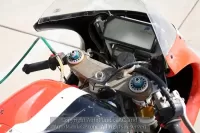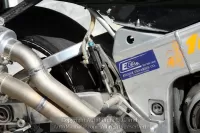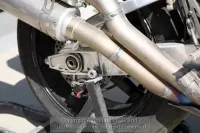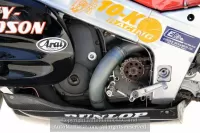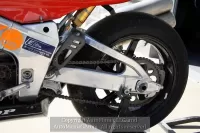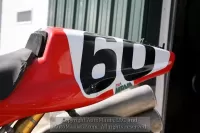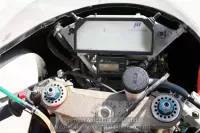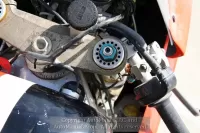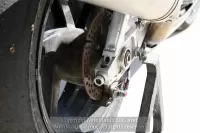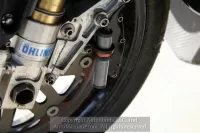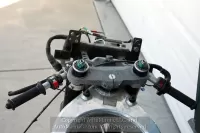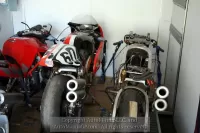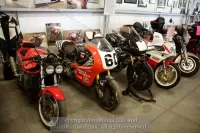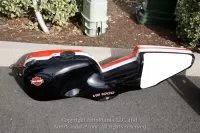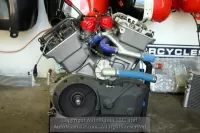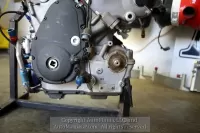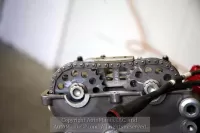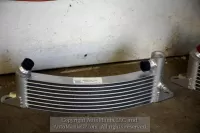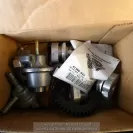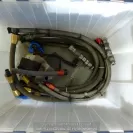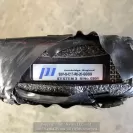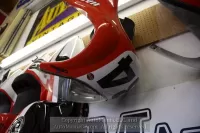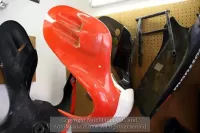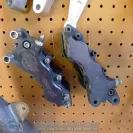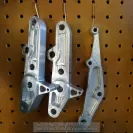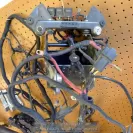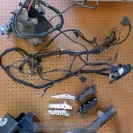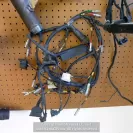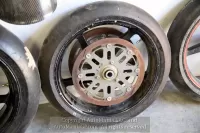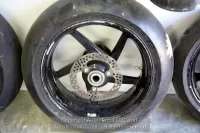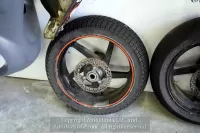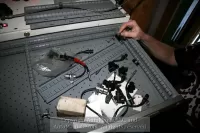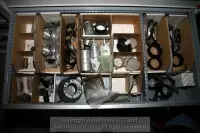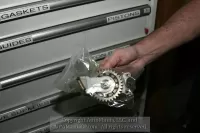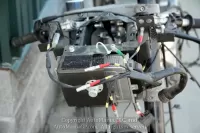1994 Harley-Davidson VR1000
This 1994 Harley-Davidson VR1000 has been sold!
Please click "back" or on the top menu for other listings.
Please click "back" or on the top menu for other listings.
[click on the image below or scroll to the thumbnail images at bottom to view the gallery.]

1994 Harley-Davidson VR1000
Price: $58,995 USD - SOLD (No Longer Available)
Price Reduced by almost $20,000
This Harley VR1000 and the collection of spares that goes with it is not for everyone or someone wanting to collect a Harley Superbike for their static collection. It is about the possibilities it presents to participate in Vintage Racing with an incredibly rare Factory Road Race Motorcycle. This a chance to own a bike built in limited quantities with no source other then the parts included with the bike to maintain and support many seasons of a unobtainium experience, of riding one of few Harley Factory Superbikes. If you are of a mind to understand what is being offered in the description and images and want to have the opportunity to race at any level, a factory Superbike, without reinventing the wheel, read on. This is not just a bike for sale, it is an experience very few will ever have to place yourself in the middle of a piece of history.
The story of Harley entering into the world of AMA Superbike racing is one of a two headed chicken attempting to go in one direction and, being of two differing minds, tripping over it’s self in the process. In 1988, Mark Tuttle, VP of Engineering at Harley, started the ball rolling by assigning engineer Mark Miller to design the engine. After getting the bottom end completed, the project was taken to Roush Racing in 1999 to complete the first running engine. From that point, Harley brought the project back to the factory to complete the program. Harley-Davidson used parts and sourcing where they could internally and from their established outside parts suppliers. Some had no experience in racing. How different when compared to Honda entering world class racing as an example, hiring the best designers, best tuners, best managers and best riders no matter who or where they worked for. Honda committed to winning what ever it took, but Harley apparently never wandered far from its normal suppliers or domestic sources during this initial gestation. Possible politics, possible mismanagement, possibility a gamble that back fired, the results were would be a failure before the Harley eventually pulled the plug seven years later.
But before that, Steve Scheibe was hired from Roush in the early 90’s to manage the development of the bike inside of Harley. Scheibe had worked on the heads and the machine's fuel injection system and was as familiar with the design as anyone at the time. Scheibe was behind the eight ball from the get go. The bike had been commissioned in 1988 and it was now 1993 before they had a running motorcycle. The original brief the bike was based upon what was currently state of the art Superbikes in 1988. It would seem today unreasonable to think that other factories would have remained stagnate in their development for five years, but the lack of experience shown by Harley did not take the lengthy development period of getting the bike to a finished state. By the mid-nineties, most Super Sport prepared motorcycles would give the VR1000 fits at the track much less Superbikes in their current state of tune. The performance goal line had not changed, it had moved into another state. The VR’s first races were in fact in 1994 with Miguel DuHamel and Fritz Kling. DuHamel could ride a wheel barrow faster then most riders of the day could ride a Superbike and it was his supreme effort that led to great qualifying at Mid-Ohio and actually leading the race until a mechanical failure stopped the run, this after grenading at Daytona part way through the race. The bike was not ready to race, it was dramatically underpowered and the results showed. Harley management fought a divided war on whether to scrap the project or continue, the result being unpredictable funding each year, lack of direction and corporate back room back biting that even included Eric Buell.
A long story made short, the bike became a rolling test bed of developing parts and new solutions to track demonstrated issues. Harley encouraged several private teams to campaign the bike including Tilley’s and the bikes for sale here, owned by Mike Canepa’s 10-K Racing, run out of San Jose Harley-Davidson.
The best finish for the VR1000 was by Tommy Wilson at Mid-Ohio in 1996 who would have finished the race in 1st place, but because a red flag had been thrown earlier in the lap, positions reverted back to the previous lap and the win was vapor. 1996 was the best year for the VR1000 with Carr and Wilson placing well and having a shot at podiums at Sears when another red flag was thrown and they suffered mechanical failures at the restart (Carr’s bike is the roller chassis included with the sale).
Disaster after disaster chased the factory team, the worse was Tommy Wilson’s crash at Loudon ending his career. The powers to be finally pulled the purse strings close that year and the bikes were sold off to the private team owners or others wanting to seize a part of history. Rumor is that the engine was the basis for the V-Rod engine, another Harley miscue that has left heads scratching.
Mike Canepa is an interesting part of the AFM and AMA racing in the late 80’s through the mid 90’s. Mike was part of the Bay Area motorcycle club racing community going through a series of bikes that were more and more sophisticated in succession. He ran a RD400 at Sears in 1981, with more RD’s and TZ’s to follow. Vintage Racing became a hobby and he won the AHRMA 250 Championship and for 450 Modified at the Pro Am Series at Sears in 1985. Canepa was racing Vintage Motocross during this time but blew his knew out in 1995 just after ordering VR1000 #13 from Harley as a street bike with the intent of racing it. Brian Le Fever rode it at Sears with limited success and Harley approached him to run the last race of the year at Phoenix with his bike. A forgotten rider who was running 883 Class was suppose race the bike, but crashed and broke his arm. Michael Barnes heard about the open seat and approached Mike about racing the bike. He finished 10th in that race. As they say, that set the hook and Mike was sucked in. Barnes and Mike decided to race the full season the following year. Harley was more then obliging and Mike ended up with more bikes and riders, adding Cal Rayborn 111 for 1996 season. Michael stayed with the program from beginning to end. The bike was always the fastest privateer bike but was at first plagued by high speed misfire due to issues in the wiring loom. They raced it at Daytona but the factory gave them the wrong washers for clutch which developed a leak. Cal, aware of the oil seeping out, crashed chasing Mike Barnes on the Britten. With Harley out of the picture and dumping everything at Mikes feet, the business of running a race team on a national level became more labor then fun. Mike finally became tired of dealing with the grief of running a team and packed it in. One of the last straws was the wrecking of the team truck on someone’s birthday celebration back east. The fun had turned to vapor. Mike brought the bikes home, unloaded them and the spares and pulled the garage door down.
Mike had 3 race prepped bikes that were ridden by both riders. The last time #60 was raced was at Sears which won the Sound of Thunder race in 1997. Along the way, the factory rebuilt the engines and updated everything except the frame and cases. The oil pump was changed, cams, pistons, rods, a 6 speed Gear box, anything the factory built Mike had within a week while Harley was involved. In 1996, Harley gave Mike an extra chassis (included with the sale) which had been raced the previous season by Chris Carr, the one that he won the pole at Pomona with. When Harley closed up shop, they offered Mike the last reiteration of the engine which has not been run and all of the latest electronics, factory quick shifter, the factory built the engine in bike along with the engine on the stand included with the bike.
The bikes have all factory race stuff. This bike has a carbon carbon AP Slipper Clutch. There is another slipper clutch in the spares. The carbon slipper clutch was one of the best slipper clutches ever at cost of $10,000 each. It has PI System 3 Plus acquisition system, same as the factory bikes. Mike told me he bought every update the factory had during his time running his team. The lower cam drive has been changed to a gear drive. The bike has the AP rotors. The rear sub frame and front sub frame are new for 97. Body work is from the original to the last version, all made by Gemini. The last set is Carbon Fiber and has not been drilled or painted. It has a Penske shock installed but a FOX shock is included as a spare. The bike has not been run since 1997. It is in need of total preparation and cosmetic restoration. Then again, where else can you buy a complete Harley Factory Superbike Race Team with enough spares to race for many seasons?
The selling price is $58,995 which includes everything shown in the images, VIN# VR056K4. See at Automania, 895 SE Gladiola Drive, Grants Pass, OR 97526. 541-479- 8888 Oregon Dealer DA1287. http://www.automaniagp.com
Automania is a Consignment Oregon Dealer selling quality, privately owned vehicles including Aprilia, Buell, BMW, Citroen, Ducati, Harley Davidson, Honda, Hummer, Kawasaki, Moto Guzzi, MV Agusta, Nissan, Ossa, Piaggio, Suzuki, Triumph, Vespa, Classic Hot Rods, Buick, Dodge, Ford, Chevrolet, Lamborghini, MG, Packard, Porsche, Rover, Shelby, Toyota, Triumph, Volkswagen and any other vehicle of interest.
The story of Harley entering into the world of AMA Superbike racing is one of a two headed chicken attempting to go in one direction and, being of two differing minds, tripping over it’s self in the process. In 1988, Mark Tuttle, VP of Engineering at Harley, started the ball rolling by assigning engineer Mark Miller to design the engine. After getting the bottom end completed, the project was taken to Roush Racing in 1999 to complete the first running engine. From that point, Harley brought the project back to the factory to complete the program. Harley-Davidson used parts and sourcing where they could internally and from their established outside parts suppliers. Some had no experience in racing. How different when compared to Honda entering world class racing as an example, hiring the best designers, best tuners, best managers and best riders no matter who or where they worked for. Honda committed to winning what ever it took, but Harley apparently never wandered far from its normal suppliers or domestic sources during this initial gestation. Possible politics, possible mismanagement, possibility a gamble that back fired, the results were would be a failure before the Harley eventually pulled the plug seven years later.
But before that, Steve Scheibe was hired from Roush in the early 90’s to manage the development of the bike inside of Harley. Scheibe had worked on the heads and the machine's fuel injection system and was as familiar with the design as anyone at the time. Scheibe was behind the eight ball from the get go. The bike had been commissioned in 1988 and it was now 1993 before they had a running motorcycle. The original brief the bike was based upon what was currently state of the art Superbikes in 1988. It would seem today unreasonable to think that other factories would have remained stagnate in their development for five years, but the lack of experience shown by Harley did not take the lengthy development period of getting the bike to a finished state. By the mid-nineties, most Super Sport prepared motorcycles would give the VR1000 fits at the track much less Superbikes in their current state of tune. The performance goal line had not changed, it had moved into another state. The VR’s first races were in fact in 1994 with Miguel DuHamel and Fritz Kling. DuHamel could ride a wheel barrow faster then most riders of the day could ride a Superbike and it was his supreme effort that led to great qualifying at Mid-Ohio and actually leading the race until a mechanical failure stopped the run, this after grenading at Daytona part way through the race. The bike was not ready to race, it was dramatically underpowered and the results showed. Harley management fought a divided war on whether to scrap the project or continue, the result being unpredictable funding each year, lack of direction and corporate back room back biting that even included Eric Buell.
A long story made short, the bike became a rolling test bed of developing parts and new solutions to track demonstrated issues. Harley encouraged several private teams to campaign the bike including Tilley’s and the bikes for sale here, owned by Mike Canepa’s 10-K Racing, run out of San Jose Harley-Davidson.
The best finish for the VR1000 was by Tommy Wilson at Mid-Ohio in 1996 who would have finished the race in 1st place, but because a red flag had been thrown earlier in the lap, positions reverted back to the previous lap and the win was vapor. 1996 was the best year for the VR1000 with Carr and Wilson placing well and having a shot at podiums at Sears when another red flag was thrown and they suffered mechanical failures at the restart (Carr’s bike is the roller chassis included with the sale).
Disaster after disaster chased the factory team, the worse was Tommy Wilson’s crash at Loudon ending his career. The powers to be finally pulled the purse strings close that year and the bikes were sold off to the private team owners or others wanting to seize a part of history. Rumor is that the engine was the basis for the V-Rod engine, another Harley miscue that has left heads scratching.
Mike Canepa is an interesting part of the AFM and AMA racing in the late 80’s through the mid 90’s. Mike was part of the Bay Area motorcycle club racing community going through a series of bikes that were more and more sophisticated in succession. He ran a RD400 at Sears in 1981, with more RD’s and TZ’s to follow. Vintage Racing became a hobby and he won the AHRMA 250 Championship and for 450 Modified at the Pro Am Series at Sears in 1985. Canepa was racing Vintage Motocross during this time but blew his knew out in 1995 just after ordering VR1000 #13 from Harley as a street bike with the intent of racing it. Brian Le Fever rode it at Sears with limited success and Harley approached him to run the last race of the year at Phoenix with his bike. A forgotten rider who was running 883 Class was suppose race the bike, but crashed and broke his arm. Michael Barnes heard about the open seat and approached Mike about racing the bike. He finished 10th in that race. As they say, that set the hook and Mike was sucked in. Barnes and Mike decided to race the full season the following year. Harley was more then obliging and Mike ended up with more bikes and riders, adding Cal Rayborn 111 for 1996 season. Michael stayed with the program from beginning to end. The bike was always the fastest privateer bike but was at first plagued by high speed misfire due to issues in the wiring loom. They raced it at Daytona but the factory gave them the wrong washers for clutch which developed a leak. Cal, aware of the oil seeping out, crashed chasing Mike Barnes on the Britten. With Harley out of the picture and dumping everything at Mikes feet, the business of running a race team on a national level became more labor then fun. Mike finally became tired of dealing with the grief of running a team and packed it in. One of the last straws was the wrecking of the team truck on someone’s birthday celebration back east. The fun had turned to vapor. Mike brought the bikes home, unloaded them and the spares and pulled the garage door down.
Mike had 3 race prepped bikes that were ridden by both riders. The last time #60 was raced was at Sears which won the Sound of Thunder race in 1997. Along the way, the factory rebuilt the engines and updated everything except the frame and cases. The oil pump was changed, cams, pistons, rods, a 6 speed Gear box, anything the factory built Mike had within a week while Harley was involved. In 1996, Harley gave Mike an extra chassis (included with the sale) which had been raced the previous season by Chris Carr, the one that he won the pole at Pomona with. When Harley closed up shop, they offered Mike the last reiteration of the engine which has not been run and all of the latest electronics, factory quick shifter, the factory built the engine in bike along with the engine on the stand included with the bike.
The bikes have all factory race stuff. This bike has a carbon carbon AP Slipper Clutch. There is another slipper clutch in the spares. The carbon slipper clutch was one of the best slipper clutches ever at cost of $10,000 each. It has PI System 3 Plus acquisition system, same as the factory bikes. Mike told me he bought every update the factory had during his time running his team. The lower cam drive has been changed to a gear drive. The bike has the AP rotors. The rear sub frame and front sub frame are new for 97. Body work is from the original to the last version, all made by Gemini. The last set is Carbon Fiber and has not been drilled or painted. It has a Penske shock installed but a FOX shock is included as a spare. The bike has not been run since 1997. It is in need of total preparation and cosmetic restoration. Then again, where else can you buy a complete Harley Factory Superbike Race Team with enough spares to race for many seasons?
The selling price is $58,995 which includes everything shown in the images, VIN# VR056K4. See at Automania, 895 SE Gladiola Drive, Grants Pass, OR 97526. 541-479- 8888 Oregon Dealer DA1287. http://www.automaniagp.com
Automania is a Consignment Oregon Dealer selling quality, privately owned vehicles including Aprilia, Buell, BMW, Citroen, Ducati, Harley Davidson, Honda, Hummer, Kawasaki, Moto Guzzi, MV Agusta, Nissan, Ossa, Piaggio, Suzuki, Triumph, Vespa, Classic Hot Rods, Buick, Dodge, Ford, Chevrolet, Lamborghini, MG, Packard, Porsche, Rover, Shelby, Toyota, Triumph, Volkswagen and any other vehicle of interest.








